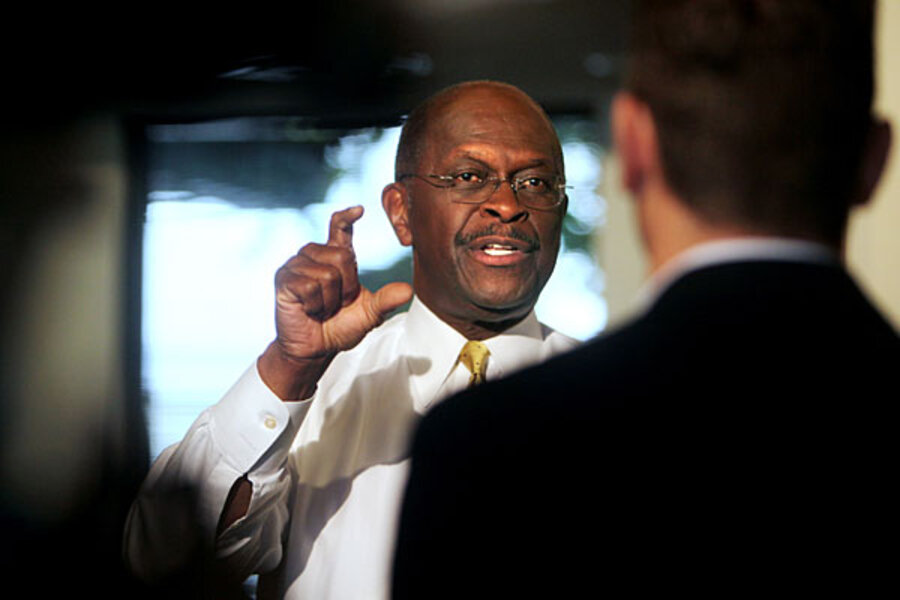Herman Cain 9-9-9 sticker shock? 18% sales tax possible in some states.
Loading...
Are you ready for some Herman Cain sales tax sticker shock?
If the Republican candidate's 9-9-9 tax plan – which would set up a 9 percent federal sales tax, 9 percent federal payroll tax, and 9 percent federal business tax – were to go into effect, the new federal sales tax would piggyback on top of state and local sales taxes already in existence.
As a result, sales taxes around the nation would be considerably higher than 9 percent.
The residents of Tennessee and Arizona would, on average, have to pay more than 18 percent in combined state, local, and federal taxes, using data from the Tax Foundation, a nonpartisan tax research group in Washington.
At least 12 states would have average sales taxes over 17 percent. California, for example, would come in at a combined rate of 17.13 percent.
And residents of four states – Delaware, Montana, New Hampshire, and Oregon – would have to start paying a sales tax. Currently, they have none.
It's a glimpse of of the potential nationwide effects of Mr. Cain's 9-9-9 plan, which would result in a median national sales-tax rate of 15.8 percent, according to the Tax Foundation data. To compare sales taxes by state, the data average local sales taxes across each state, since they can vary widely from one locality to another.
To the Cain campaign, these statistics miss the point. Since personal taxes would drop significantly with only one, 9 percent tax rate, individuals would have more disposable income to buy things which would be more expensive, 9-9-9 backers say.
Here's one example: An individual who currently makes $174,000 would be in the 28 percent tax bracket. According to moneychimp.com, that person – married but filing separately – would owe $42,337. But under 9-9-9, the person’s tax would be $15,660 – a savings of $26,667.
“I understand his theory,” says Michelle Ahlman, executive director of the Arizona Retailers Association in Mesa.
But she worries about “sticker shock,” when customers see how much an item will be with the new sales tax. “People will balk at it and either turn to buying online or not spend at all,” she says.
How much more would some things cost?
- In New York at the Lord & Taylor department store, a non-label cashmere sweater was priced at $179.99. Adding on New York’s 8.48 percent sales tax, it would cost $195.25. With Cain’s 17 percent tax rate, it would total $211.45, or $16.20 more.
- At Best Buy in Boston, a flat screen 55-inch, flat-screen TV sells for $2,549. With local and state sales tax, that totals $2,708.31. Under 9-9-9, it would cost 2,937.72, or $229.41 more.
- At a Barnes & Noble bookstore in Boston, Herman Cain’s autobiography, "This is Herman Cain!" would retail with 6.25 percent tax for $26.56. Adding the candidate’s own sales tax, it would cost $28.81, or $2.25 more.
The extra tax would be especially noticeable on a significant purchase such as an automobile. For example, at Commonwealth Honda in Lawrence, Mass., a salesman quoted a price of $22,673.49 for a 2011 four-door Honda Accord LX. Under Cain’s tax proposal, the car would cost $24,553.32, or $1,879.83 more.
The higher sales taxes could encourage the practice of crossing state lines to buy products in places where sales taxes would be lower. For instance, some South Dakota residents buy food and clothing in Minnesota, which does not tax those items.
“The disparity between the states and commerce would be pretty widespread,” says Shawn Lyons, chairman of the board of the Council of State Retail Associations.
Sales taxes in Delaware would be at 9 percent under the 9-9-9 plan, while they would hit an average of 16.03 percent in neighboring New Jersey and 15 percent in Maryland.
Retailers would be particularly unhappy if e-retailers did not have to pay the sales tax. Under current law – upheld by the US Supreme Court – online retailers are not responsible for collecting taxes in a state where they do not have a physical presence. There are currently two bills before Congress to try to make retailers such as Amazon.com pay state sales taxes.
Presumably, e-commerce would have to pay the federal sales tax under 9-9-9, but neither Cain’s campaign office, nor his senior economic advisor, Rich Lowrie, returned phone calls or e-mails.
“If they don’t have to pay the tax, it will kill us,” says Arizona's Ahlmer.
If the 9-9-9 plan were enacted, the most expensive sales taxes in the nation, according to the Tax Foundation, would be in Tuba City, Ariz., where there is currently a combined rate of 13.73 percent, including a 6 percent tax for the local Indian government. With 9-9-9, the small town (pop. 8,225) would have a sales tax of 22.73 percent.
• Geoff Johnson contributed to this report





